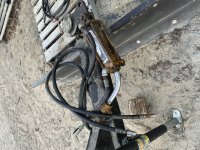Thunder chicken
Gold Member
I posted a thread recently (thought it was here in hydraulics but wasn’t, didn’t know how to move the thread)
Thread 'Rear blade angle cylinder bent rod'
Rear blade angle cylinder bent rod
I have a rear 3pt hitch blade. I put a cylinder on to control the angle.
The blade is a 8’ Farm King. It had manual angle before. The mounts for the manual support bar and the optional cylinder are the same. The mount on the King pin is about a 6” arm.
I used a 3” cylinder with a 1 1/4” rod, as thats what I had. The OEM kit uses a 3 1/2” bore x 1 1/2” rod cylinder, a bit beefier.
I bent the rod while angling the blade (ram extended) and the forward corner of the blade caught something (didn’t even feel it actually).
- Is a 1 1/2” rod cylinder ‘that’ much stronger than the 1 1/4?
- there are varying opinions and info on using a crossover relief valve (double crossover relief?). Looks like they are sometime used in double acting cylinders in other applications such as backhoe thumbs. This OEM does not use one.
- in the future I guess I won’t pull the blade angled with the ram extended.
Looking for some thoughts on if the cross over relief would be a good use of $100 or if there’s another way to protect the cylinder with a relief valve of some sort.
In this situation the relief would pass fluid from one end of the cylinder to the other (I understand the amount of moving oil would be different from one end to the other)
Thanks for any hydraulic insight!
Thread 'Rear blade angle cylinder bent rod'
Rear blade angle cylinder bent rod
I have a rear 3pt hitch blade. I put a cylinder on to control the angle.
The blade is a 8’ Farm King. It had manual angle before. The mounts for the manual support bar and the optional cylinder are the same. The mount on the King pin is about a 6” arm.
I used a 3” cylinder with a 1 1/4” rod, as thats what I had. The OEM kit uses a 3 1/2” bore x 1 1/2” rod cylinder, a bit beefier.
I bent the rod while angling the blade (ram extended) and the forward corner of the blade caught something (didn’t even feel it actually).
- Is a 1 1/2” rod cylinder ‘that’ much stronger than the 1 1/4?
- there are varying opinions and info on using a crossover relief valve (double crossover relief?). Looks like they are sometime used in double acting cylinders in other applications such as backhoe thumbs. This OEM does not use one.
- in the future I guess I won’t pull the blade angled with the ram extended.
Looking for some thoughts on if the cross over relief would be a good use of $100 or if there’s another way to protect the cylinder with a relief valve of some sort.
In this situation the relief would pass fluid from one end of the cylinder to the other (I understand the amount of moving oil would be different from one end to the other)
Thanks for any hydraulic insight!
Attachments
Last edited:

